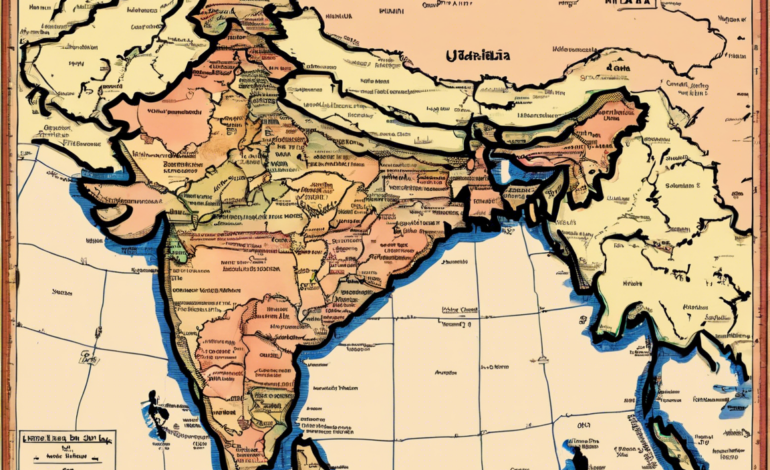
Exploring India: A Diverse Map of Cultures
India is a land of vibrant diversity, a melting pot of numerous cultures, traditions, and languages. From the snowy peaks of the Himalayas in the north to the sandy shores of Kerala in the south, India’s rich tapestry of culture is a source of endless fascination and exploration. In this article, we will delve deep into the diverse cultures of India, shedding light on the myriad aspects that make this country truly unique and captivating.
The Cultural Kaleidoscope of India
India is a country where cultural diversity is not just a term, but a way of life. With over 1.3 billion people belonging to various ethnicities, religions, and linguistic backgrounds, the country is a kaleidoscope of traditions and customs. Let’s explore some of the key facets of India’s diverse cultural map:
1. Languages and Literature
India is home to 22 officially recognized languages, and more than 19,500 languages or dialects spoken across the country. Each state in India has its own official language, adding to the linguistic richness of the nation. Sanskrit, the ancient language of India, has had a profound influence on the country’s literature and culture. Indian literature, spanning from the ancient epics like the Mahabharata and Ramayana to modern-day novels and poetry, reflects the diversity of thought and expression in the country.
2. Festivals and Celebrations
India is known for its vibrant festivals that celebrate various religious, cultural, and social occasions. From Diwali – the festival of lights, to Holi – the festival of colors, to Eid and Christmas, Indians come together to revel in the festivities with great enthusiasm and joy. Each festival has its unique rituals, traditions, and delicacies associated with it, adding to the cultural tapestry of the country.
3. Cuisine and Culinary Traditions
Indian cuisine is as diverse as its culture, with each region boasting its distinctive flavors, spices, and cooking styles. From the fiery curries of the north to the aromatic biryanis of the south, Indian food offers a culinary journey like no other. Masala chai, samosas, naan, and dosa are just a few of the iconic dishes that have captured the hearts and taste buds of people worldwide.
4. Arts and Crafts
India has a rich tradition of arts and crafts that date back centuries. From intricate handicrafts like pottery, textiles, and jewelry to classical dance forms like Bharatanatyam and Kathak, Indian artistry is a testament to the country’s deep-rooted cultural heritage. Madhubani paintings, Kanjeevaram sarees, and Pashmina shawls are just a few examples of the exquisite craftsmanship that India is renowned for.
5. Religion and Spirituality
India is the birthplace of major religions like Hinduism, Buddhism, Jainism, and Sikhism, making it a spiritual hub for millions of believers worldwide. The country is dotted with temples, mosques, churches, and gurudwaras, each steeped in history and architectural splendor. Pilgrimage sites like Varanasi, Amritsar, and Bodh Gaya draw devotees and tourists alike, seeking spiritual solace and enlightenment.
Exploring India’s Cultural Mosaic
Travelling through India is a sensory overload, with every corner offering a new perspective on its diverse cultures. Whether it’s the bustling markets of Delhi, the serene backwaters of Kerala, or the majestic forts of Rajasthan, each region has its charm and character that is a testament to India’s cultural mosaic. Here are some key destinations that offer a glimpse into the diverse cultures of India:
-
Jaipur, Rajasthan: Known as the Pink City, Jaipur is a vibrant blend of Rajputana grandeur and bustling bazaars. The city’s magnificent forts, palaces, and colorful handicrafts showcase Rajasthan’s rich cultural heritage.
-
Varanasi, Uttar Pradesh: Considered one of the oldest cities in the world, Varanasi is a spiritual melting pot on the banks of the Ganges river. The city’s ghats, temples, and aarti ceremonies offer a glimpse into India’s deep-rooted spiritual traditions.
-
Kochi, Kerala: Nestled along the Arabian Sea, Kochi is a charming blend of Portuguese, Dutch, and British influences. The city’s vibrant art scene, backwater cruises, and traditional Kathakali performances highlight Kerala’s unique cultural ethos.
Frequently Asked Questions (FAQs)
1. What makes Indian culture unique?
Indian culture is unique for its diversity, inclusivity, and age-old traditions that have been passed down through generations. The country’s rich history, mythology, and arts make it a cultural treasure trove like no other.
2. How do festivals influence Indian culture?
Festivals play a significant role in Indian culture by bringing communities together, fostering a sense of unity and joy, and preserving age-old traditions and customs. Festivals also offer a glimpse into the religious and social fabric of the country.
3. What are some must-try dishes in Indian cuisine?
Some must-try dishes in Indian cuisine include butter chicken, biryani, masala dosa, palak paneer, chaat, and gulab jamun. These dishes represent the diverse flavors and culinary traditions of different regions in India.
4. How has globalization impacted Indian culture?
Globalization has brought about a fusion of cultures in India, leading to the adoption of Western trends, lifestyles, and technologies. While this has led to cultural exchange and economic growth, it has also raised concerns about preserving India’s traditional heritage and values.
5. What role does art play in Indian culture?
Art has always played a crucial role in Indian culture, serving as a medium of expression, storytelling, and spiritual exploration. From classical dances to folk music, Indian art forms reflect the country’s rich heritage and creativity.
In conclusion, India’s cultural tapestry is a mesmerizing blend of colors, traditions, and customs that continue to captivate the world. Exploring India is not just a journey through its geography but a deep dive into its soul, where each moment reveals a new facet of its diverse and fascinating cultures. Whether it’s the bustling streets of Mumbai, the serene backwaters of Kerala, or the majestic forts of Rajasthan, India beckons travelers to embark on a cultural odyssey like no other.
